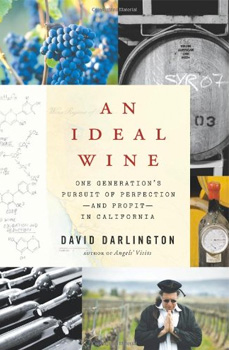

An Ideal Wine: One Generation’s Pursuit of Perfection—and Profit—in California
Author: by David Darlington
Publisher: HarperCollins 2011
Price: $26.99
It would be hard to overstate the magnitude of change that has swept across the California wine industry in the last two decades. In size, output, acreage and economic scale the industry has grown dramatically; in expression and range of offerings, it has spun off into unimagined orbits, with diversity that can rival any other country in the world. Technologies that wouldn’t have been dreamed of 20 years ago are now standard practice; methods employed to render a wine palatable, consistent, critic-worthy, great—serving any one of several “ideals”—are now commonplace.
California wines embrace high-, middle- and lowbrow aesthetics, straddling elitism and populism, the artisanal and the industrial, the painstakingly natural and the spectacularly contrived. Changes have occurred with such tremendous velocity that it’s all an observer can do to keep abreast of them.
With An Ideal Wine: One Generation’s Pursuit of Perfection—and Profit—in California, David Darlington has come closer than anyone in providing a definitive chronicle of these changes. A writer at large for this magazine and a gifted reporter who’s covered a wide range of topics in his career, from condors and zinfandel to Area 51, Darlington explores some of the California wine industry’s broader issues by profiling some of its most colorful characters, in a chronicle that captures the current zeitgeist of the industry.
The broad canvas upon which Darlington has applied his narrative rests on two iconic industry figures, Randall Grahm and Leo McCloskey. Grahm is the founder, proprietor and President for Life of Bonny Doon Vineyards; McCloskey runs the shrewdly clinical winery consulting service called Enologix. Both men are bright, verbal and charismatic characters; their philosophical distance gives the book its tremendous resonance and range.
Grahm is famously voluble. In a career spanning nearly 30 years, he has produced many memorable wines, but is better known for being a dynamic, eccentric public figure and marketing master who has stretched the definition of vigneron into wildly exotic territories. Darlington captures Grahm’s exhibitions of wit, cheek and self-confession as he transitions from a multisource, hydra-headed winery to something smaller and more artisanal, with more vineyard focus, marked by a new devotion to biodynamic farming. Grahm does this as only he can, with much bombast, hand-wringing, self-doubt and public posturing: his Twitter feed, Darlington reports, is read by more than 320,000 followers, and he may be the first winemaker ever to appear (via Skype) on Oprah.
Leo McCloskey prefers to labor behind the scenes, working with winemakers to sculpt their wines with formulaic precision to conform to an aesthetic designed to coincide with some of the industry’s influential critics, most notably Robert M. Parker, Jr. He teaches his clients to chemically analyze their wines—the ratios of fruit, tannin, acid and such—;and to strike for a composite that’s built on ripe fruit, new oak and a supple mouthfeel, the latter achieved with “high complex anthocyanin,” a compound that McCloskey calls his company’s trademark. “My goal” says McCloskey,“is to make my customers self-sufficient so that metrics alone can solve all their problems.”
Chapter by chapter Darlington weaves a dialectic between these two characters and their divergent approaches to the same challenge: creating and selling wine in a complex, competitive marketplace.
Along the way Darlington links other stories into a narrative patchwork, a chronicle of change in the late 20th and early 21st centuries. He includes side trips to profile Helen and Larry Turley, Jess Jackson and Frog’s Leap’s John Williams. He tells the story of Mike Benziger’s conversion from fighting-varietals heavy-weight to biodynamics guru, and of Clark Smith’s transformation from winemaker to wine-tailor, master of the tools used to elevate or repair less than ideal wines.
Darlington has a tremendous eye for detail, evoking both bucolic vineyards and gleaming lab rooms with equal clarity. But his greatest gift as a reporter may be his light touch, the way he keeps to the periphery and allows his subjects and their stories to carry the narrative. Through skillful transitions, their stories brush up against one another, while the author remains wisely agnostic to the very end, leaving the reader to decide whose definition of ideal is worthy of pursuit.
Patrick J. Comiskey covers US wines for Wine & Spirits magazine, focusing on the Pacific Northwest, California’s Central Coast and New York’s Finger Lakes.
This story appears in the print issue of Winter 2012.
Like what you read? Subscribe today.
















